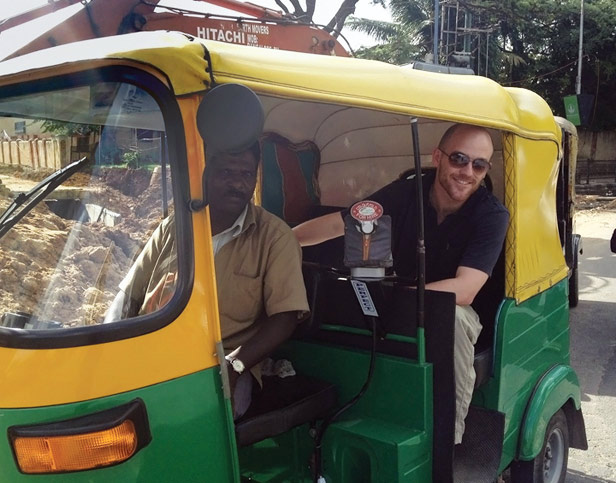
Horns blare, motors whine, and black diesel exhaust spews into the air as my driver swerves his three-wheeled open-air auto rickshaw around a pothole, simultaneously cutting off a white two-door coupe and a woman wrapped in crimson on a rusty bicycle. To my left, women with baskets on their heads crouch to stack neat rows of oranges, apples, melons, and plums on patterned blankets laid in the dirt. A dairy cow rummages through a trash pile while I lean back on the rickshaw’s cushioned bench to contemplate whether I was sane when I chose my summer internship.
Crazy or not, I came to Bangalore to reconnect with my passion for space.
That I would seek communion with the high frontier in a country containing roughly one-third of the world’s poor people might seem odd. India invests more than $1 billion annually in its space program even as it struggles to feed 800 million people living on less than $2 a day. I came here to ask: How can a poor nation like India justify such a program?
I’ve always been a huge space nut; I started working for NASA as a co-op student before I could order a Budweiser at Applebee’s. But after watching the space shuttle Atlantis touch down for the last time in July 2011, I began to doubt the relevance of spaceflight given other national interests. Luckily, I got the chance to explore that doubt during an unpaid sabbatical to complete a one-year science writing master’s program at MIT. The last component of the degree was a summer internship, and I chose to spend it at the Indian Institute of Science. India is a country on the rise, I thought. Plus, it has a space program. And I love Indian food. Win-win-win for me.
In Bangalore, I met with leaders in the Indian Space Research Organization (ISRO), including the director of the ISRO Satellite Centre and the man in charge of India’s Chandrayaan robotic moon missions. I talked with students, climate scientists, propulsion engineers, shopkeepers, the cardiac surgeon who treated Mother Teresa, and a room of 150 middle schoolers. In all these discussions and throughout my research, what amazed me most was the pragmatism of India’s approach to space development. When ISRO was founded in 1969, India’s space leaders envisioned a program that would use space technology in service to mankind—and specifically to help the poor people of India.
Today, the country operates one of the world’s largest and most advanced civilian networks of remote sensing satellites. This system helps find well water in dry regions, project crop yields, determine the health of fisheries, and forecast floods. Satellites gather meteorological data for long-range climate modeling and are used to sound disaster preparation alarms in villages with no other access to warnings. They broadcast television programs about agriculture, health, family planning, rural development, and literacy to 55,000 schools and colleges. A telemedicine program connects specialist doctors in urban areas to sick people in remote villages via satellite links and mobile units known as “clinics on wheels.” So far, ISRO has built a system that it says treats 150,000 people each year.
Manned space programs and moon missions and a plan to send a robotic probe to Mars are important because they keep India’s space talent sharp and challenged while pushing the boundaries of knowledge. But they represent only about 5 percent of total Indian space spending. In India, the real focus of space science is not in the sky but on the ground, where people sell fruit grown in fields watched over by eyes hundreds of miles overhead, or crowd around television sets learning about personal hygiene and crop diseases in villages worlds away from what we consider high-tech civilization.
I still think there’s an important role for human spaceflight, and I’m convinced that NASA, which spends only about 10 percent of its budget on earth science, will one day lead humanity even farther into the cosmos. But the Indian approach has widened my perspective. Space is a vital frontier for those seeking to improve life on earth, even—and perhaps especially—in a developing nation.
After completing a summer writing internship at the Indian Institute of Science, Garret Fitzpatrick, SM ’12, returned to NASA as an aerospace engineer at the Ames Research Center.
Keep Reading
Most Popular
Large language models can do jaw-dropping things. But nobody knows exactly why.
And that's a problem. Figuring it out is one of the biggest scientific puzzles of our time and a crucial step towards controlling more powerful future models.
How scientists traced a mysterious covid case back to six toilets
When wastewater surveillance turns into a hunt for a single infected individual, the ethics get tricky.
The problem with plug-in hybrids? Their drivers.
Plug-in hybrids are often sold as a transition to EVs, but new data from Europe shows we’re still underestimating the emissions they produce.
Stay connected
Get the latest updates from
MIT Technology Review
Discover special offers, top stories, upcoming events, and more.